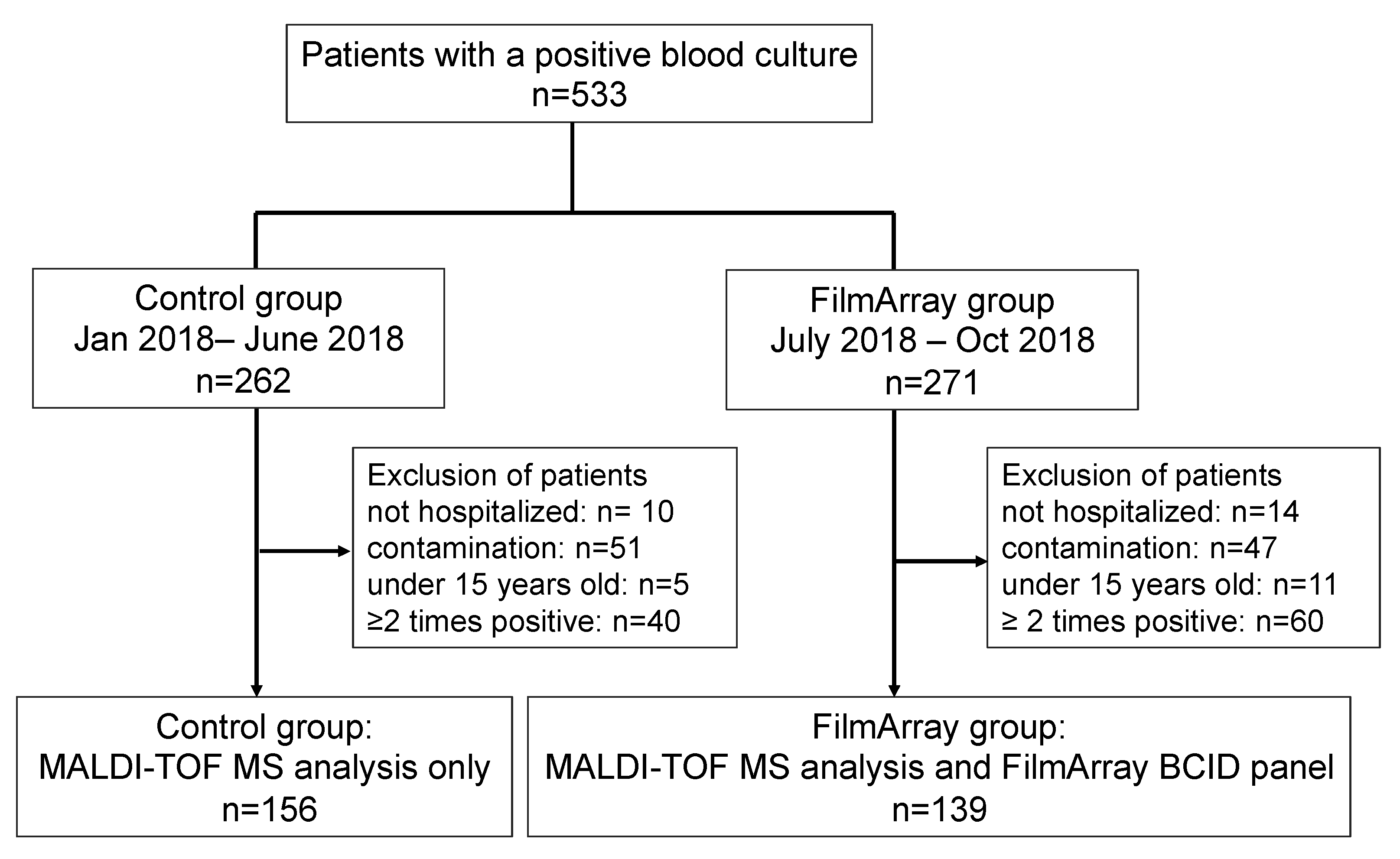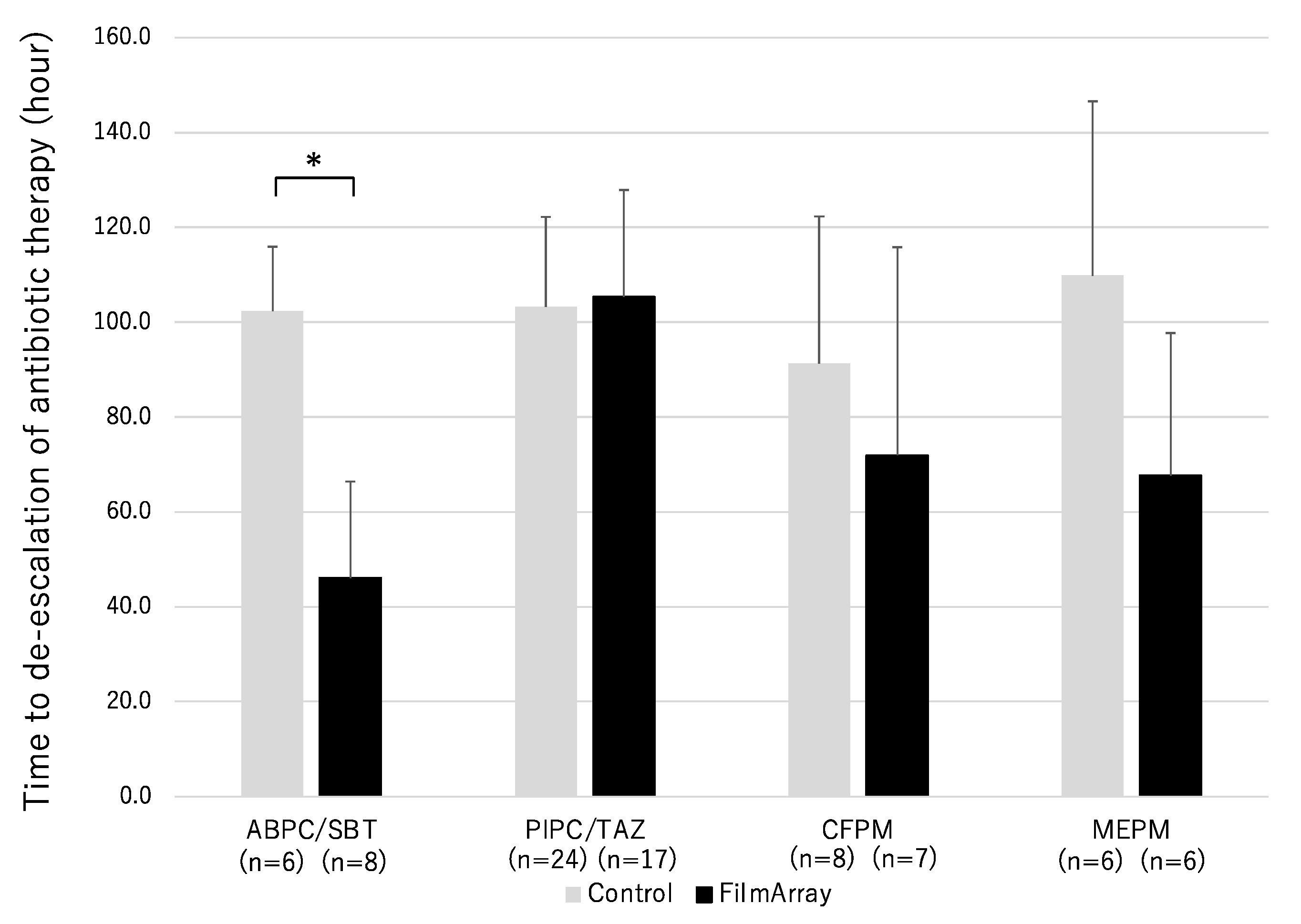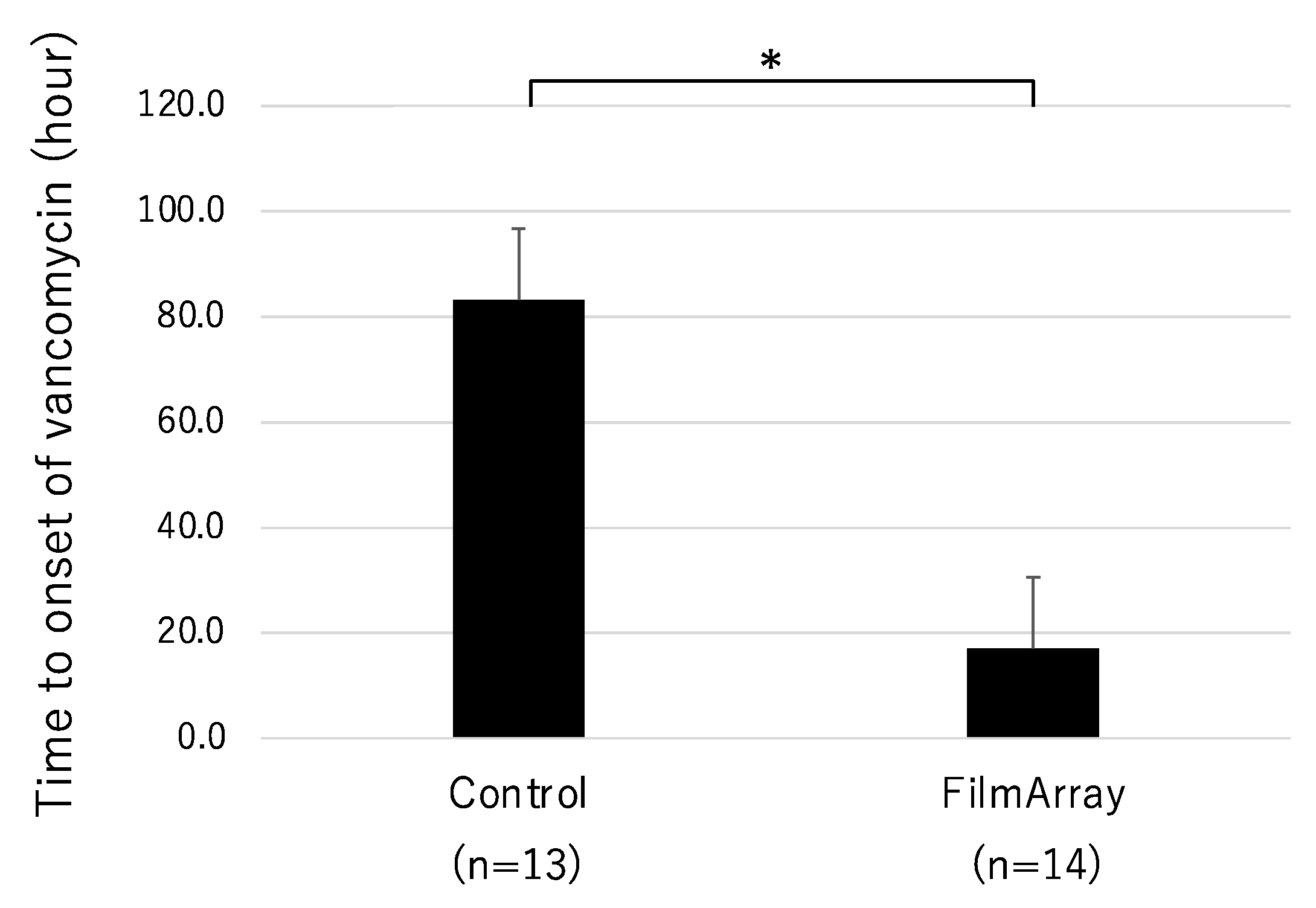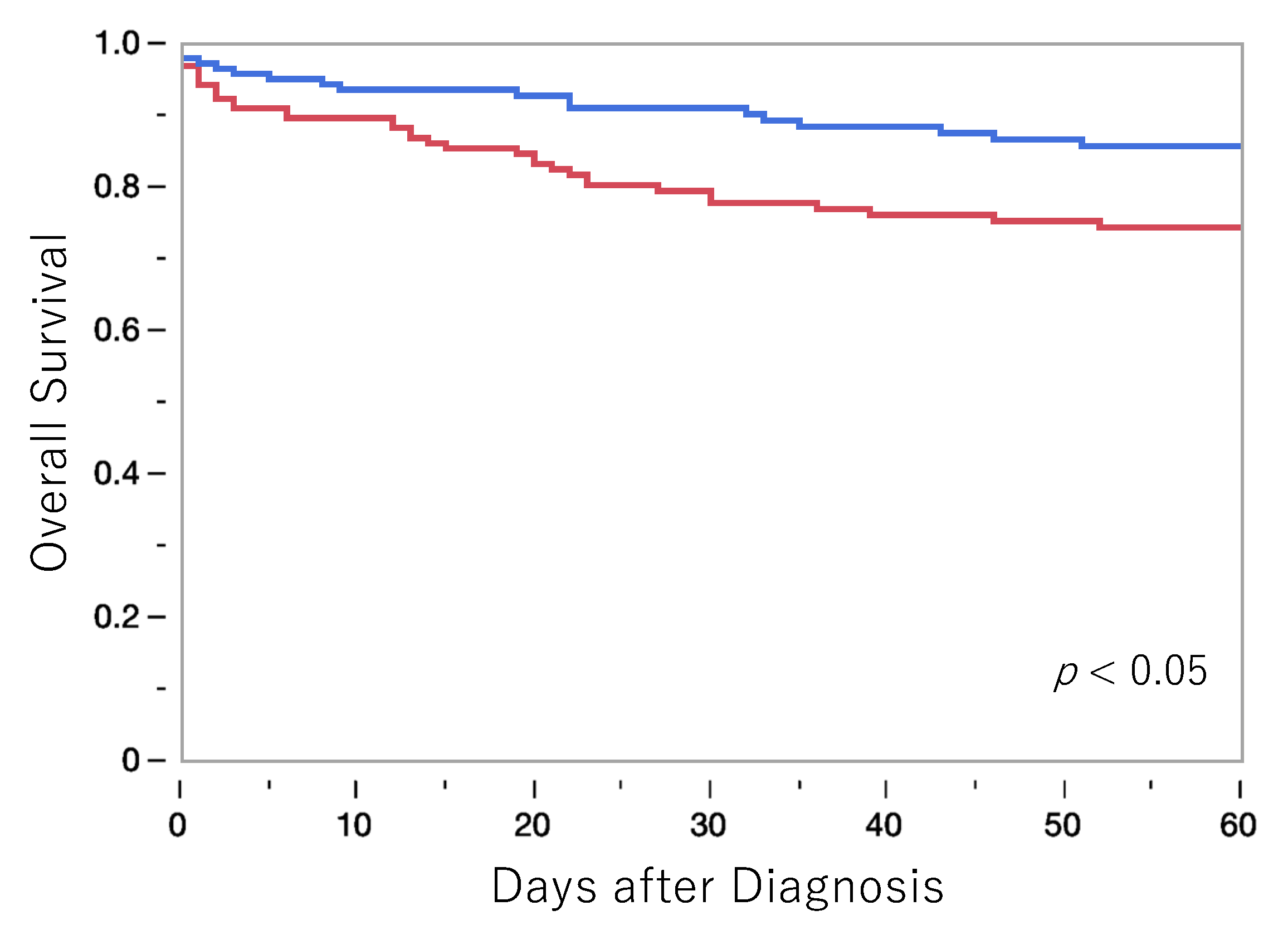Impact of the FilmArray Rapid Multiplex PCR Assay on Clinical Outcomes of Patients with Bacteremia
Abstract
1. Introduction
2. Methods
2.1. Patients
2.2. Laboratory Testing
2.3. Antimicrobial Stewardship
2.4. Data Handling
2.5. Outcomes
2.6. Statistical Analyses
3. Results
3.1. Patient Characteristics
3.2. FA-BCID Microbiological Performances
3.3. Treatment Selection According to the Analyses
3.4. Clinical Outcomes
4. Discussion
5. Conclusions
Author Contributions
Funding
Institutional Review Board Statement
Informed Consent Statement
Data Availability Statement
Acknowledgments
Conflicts of Interest
References
- Goto, M.; Al-Hasan, M.N. Overall burden of bloodstream infection and nosocomial bloodstream infection in North America and Europe. Clin. Microbiol. Infect. 2013, 19, 501–509. [Google Scholar] [CrossRef]
- Bearman, G.M.; Wenzel, R.P. Bacteremias: A leading cause of death. Arch. Med. Res. 2005, 36, 646–659. [Google Scholar] [CrossRef] [PubMed]
- Vernaz, N.; Hill, K.; Leggeat, S.; Nathwani, D.; Philips, G.; Bonnabry, P.; Davey, P. Temporal effects of antibiotic use and Clostridium difficile infections. J. Antimicrob. Chemother. 2009, 63, 1272–1275. [Google Scholar] [CrossRef]
- Tumbarello, M.; Sanguinetti, M.; Montuori, E.; Trecarichi, E.M.; Posteraro, B.; Fiori, B.; Citton, R.; D’Inzeo, T.; Fadda, G.; Cauda, R.; et al. Predictors of mortality in patients with bloodstream infections caused by extended-spectrum-beta-lactamase-producing Enterobacteriaceae: Importance of inadequate initial antimicrobial treatment. Antimicrob. Agents Chemother. 2007, 51, 1987–1994. [Google Scholar] [CrossRef]
- Ledeboer, N.A.; Lopansri, B.K.; Dhiman, N.; Cavagnolo, R.; Carroll, K.C.; Granato, P.; Thomson, R., Jr.; Butler-Wu, S.M.; Berger, H.; Samuel, L.; et al. Identification of Gram-Negative Bacteria and Genetic Resistance Determinants from Positive Blood Culture Broths by Use of the Verigene Gram-Negative Blood Culture Multiplex Microarray-Based Molecular Assay. J. Clin. Microbiol. 2015, 53, 2460–2472. [Google Scholar] [CrossRef] [PubMed]
- Buehler, S.S.; Madison, B.; Snyder, S.R.; Derzon, J.H.; Cornish, N.E.; Saubolle, M.A.; Weissfeld, A.S.; Weinstein, M.P.; Liebow, E.B.; Wolk, D.M. Effectiveness of Practices To Increase Timeliness of Providing Targeted Therapy for Inpatients with Bloodstream Infections: A Laboratory Medicine Best Practices Systematic Review and Meta-analysis. Clin. Microbiol. Rev. 2016, 29, 59–103. [Google Scholar] [CrossRef] [PubMed]
- Blaschke, A.J.; Heyrend, C.; Byington, C.L.; Fisher, M.A.; Barker, E.; Garrone, N.F.; Thatcher, S.A.; Pavia, A.T.; Barney, T.; Alger, G.D.; et al. Rapid identification of pathogens from positive blood cultures by multiplex polymerase chain reaction using the FilmArray system. Diagn. Microbiol. Infect. Dis. 2012, 74, 349–355. [Google Scholar] [CrossRef]
- Altun, O.; Almuhayawi, M.; Ullberg, M.; Ozenci, V. Clinical evaluation of the FilmArray blood culture identification panel in identification of bacteria and yeasts from positive blood culture bottles. J. Clin. Microbiol. 2013, 51, 4130–4136. [Google Scholar] [CrossRef] [PubMed]
- Hirotsu, Y.; Maejima, M.; Shibusawa, M.; Amemiya, K.; Nagakubo, Y.; Hosaka, K.; Sueki, H.; Hayakawa, M.; Mochizuki, H.; Tsutsui, T.; et al. Analysis of a persistent viral shedding patient infected with SARS-CoV-2 by RT-qPCR, FilmArray Respiratory Panel v2.1, and antigen detection. J. Infect. Chemother. 2021, 27, 406–409. [Google Scholar] [CrossRef] [PubMed]
- Hirotsu, Y.; Maejima, M.; Shibusawa, M.; Natori, Y.; Nagakubo, Y.; Hosaka, K.; Sueki, H.; Amemiya, K.; Hayakawa, M.; Mochizuki, H.; et al. Direct comparison of Xpert Xpress, FilmArray Respiratory Panel, Lumipulse antigen test, and RT-qPCR in 165 nasopharyngeal swabs. BMC Infect. Dis. 2022, 22, 221. [Google Scholar] [CrossRef]
- Zheng, X.; Polanco, W.; Carter, D.; Shulman, S. Rapid identification of pathogens from pediatric blood cultures by use of the FilmArray blood culture identification panel. J. Clin. Microbiol. 2014, 52, 4368–4371. [Google Scholar] [CrossRef] [PubMed]
- Verroken, A.; Despas, N.; Rodriguez-Villalobos, H.; Laterre, P.F. The impact of a rapid molecular identification test on positive blood cultures from critically ill with bacteremia: A pre-post intervention study. PLoS ONE 2019, 14, e0223122. [Google Scholar] [CrossRef]
- Sharma, R.; Szucs, T.; Reinhartsen, T.A. ISO 9001:2015 Internal Audits for Financial and Strategic Decisions in Reducing Blood Culture Contamination. Qual. Manag. Health Care 2023, 32, 40–45. [Google Scholar] [CrossRef] [PubMed]
- Brooks, D.; Smith, A.; Young, D.; Fulton, R.; Booth, M.G. Mortality in intensive care: The impact of bacteremia and the utility of systemic inflammatory response syndrome. Am. J. Infect. Control. 2016, 44, 1291–1295. [Google Scholar] [CrossRef] [PubMed]
- Patel, R. Matrix-assisted laser desorption ionization-time of flight mass spectrometry in clinical microbiology. Clin. Infect. Dis. 2013, 57, 564–572. [Google Scholar] [CrossRef]
- Oda, S.; Aibiki, M.; Ikeda, T.; Imaizumi, H.; Endo, S.; Ochiai, R.; Kotani, J.; Shime, N.; Nishida, O.; Noguchi, T.; et al. The Japanese guidelines for the management of sepsis. J. Intensive Care 2014, 2, 55. [Google Scholar] [CrossRef]
- Saito, K.; Endo, S.; Katsumi, M.; Ishizawa, C.; Fujikawa, Y.; Inomata, S.; Toyokawa, M.; Kaku, M. Evaluation of the FilmArray Blood Culture Identification Panel on Detection of Pathogenic Microorganisms in Positive Blood Cultures: The First Clinical Report in Japan. Jpn. J. Infect. Dis. 2018, 71, 145–147. [Google Scholar] [CrossRef]
- MacVane, S.H.; Nolte, F.S. Benefits of Adding a Rapid PCR-Based Blood Culture Identification Panel to an Established Antimicrobial Stewardship Program. J. Clin. Microbiol. 2016, 54, 2455–2463. [Google Scholar] [CrossRef]
- Dellinger, R.P.; Levy, M.M.; Rhodes, A.; Annane, D.; Gerlach, H.; Opal, S.M.; Sevransky, J.E.; Sprung, C.L.; Douglas, I.S.; Jaeschke, R.; et al. Surviving sepsis campaign: International guidelines for management of severe sepsis and septic shock: 2012. Crit. Care Med. 2013, 41, 580–637. [Google Scholar] [CrossRef]
- Salimnia, H.; Fairfax, M.R.; Lephart, P.R.; Schreckenberger, P.; DesJarlais, S.M.; Johnson, J.K.; Robinson, G.; Carroll, K.C.; Greer, A.; Morgan, M.; et al. Evaluation of the FilmArray Blood Culture Identification Panel: Results of a Multicenter Controlled Trial. J. Clin. Microbiol. 2016, 54, 687–698. [Google Scholar] [CrossRef]
- Garnacho-Montero, J.; Gutierrez-Pizarraya, A.; Escoresca-Ortega, A.; Corcia-Palomo, Y.; Fernandez-Delgado, E.; Herrera-Melero, I.; Ortiz-Leyba, C.; Marquez-Vacaro, J.A. De-escalation of empirical therapy is associated with lower mortality in patients with severe sepsis and septic shock. Intensive Care Med. 2014, 40, 32–40. [Google Scholar] [CrossRef] [PubMed]
- Anton-Vazquez, V.; Hine, P.; Krishna, S.; Chaplin, M.; Planche, T. Rapid versus standard antimicrobial susceptibility testing to guide treatment of bloodstream infection. Cochrane Database Syst. Rev. 2021, 5, Cd013235. [Google Scholar] [CrossRef]
- Banerjee, R.; Komarow, L.; Virk, A.; Rajapakse, N.; Schuetz, A.N.; Dylla, B.; Earley, M.; Lok, J.; Kohner, P.; Ihde, S.; et al. Randomized Trial Evaluating Clinical Impact of RAPid IDentification and Susceptibility Testing for Gram-negative Bacteremia: RAPIDS-GN. Clin. Infect. Dis. 2021, 73, e39–e46. [Google Scholar] [CrossRef]
- Allaouchiche, B.; Jaumain, H.; Zambardi, G.; Chassard, D.; Freney, J. Clinical impact of rapid oxacillin susceptibility testing using a PCR assay in Staphylococcus aureus bactaeremia. J. Infect. 1999, 39, 198–204. [Google Scholar] [CrossRef] [PubMed]
- Banerjee, R.; Teng, C.B.; Cunningham, S.A.; Ihde, S.M.; Steckelberg, J.M.; Moriarty, J.P.; Shah, N.D.; Mandrekar, J.N.; Patel, R. Randomized Trial of Rapid Multiplex Polymerase Chain Reaction-Based Blood Culture Identification and Susceptibility Testing. Clin. Infect. Dis. 2015, 61, 1071–1080. [Google Scholar] [CrossRef] [PubMed]
- Beuving, J.; Wolffs, P.F.; Hansen, W.L.; Stobberingh, E.E.; Bruggeman, C.A.; Kessels, A.; Verbon, A. Impact of same-day antibiotic susceptibility testing on time to appropriate antibiotic treatment of patients with bacteraemia: A randomised controlled trial. Eur. J. Clin. Microbiol. Infect. Dis. 2015, 34, 831–838. [Google Scholar] [CrossRef] [PubMed]
- Emonet, S.; Charles, P.G.; Harbarth, S.; Stewardson, A.J.; Renzi, G.; Uckay, I.; Cherkaoui, A.; Rougemont, M.; Schrenzel, J. Rapid molecular determination of methicillin resistance in staphylococcal bacteraemia improves early targeted antibiotic prescribing: A randomized clinical trial. Clin. Microbiol. Infect. 2016, 22, 946.e9–946.e15. [Google Scholar] [CrossRef]
- Kim, J.H.; Kim, I.; Kang, C.K.; Jun, K.I.; Yoo, S.H.; Chun, J.Y.; Jung, J.; Kim, Y.J.; Kim, D.Y.; Jo, H.B.; et al. Enhanced antimicrobial stewardship based on rapid phenotypic antimicrobial susceptibility testing for bacteraemia in patients with haematological malignancies: A randomized controlled trial. Clin. Microbiol. Infect. 2021, 27, 69–75. [Google Scholar] [CrossRef]
- Timbrook, T.T.; Morton, J.B.; McConeghy, K.W.; Caffrey, A.R.; Mylonakis, E.; LaPlante, K.L. The Effect of Molecular Rapid Diagnostic Testing on Clinical Outcomes in Bloodstream Infections: A Systematic Review and Meta-analysis. Clin. Infect. Dis. 2017, 64, 15–23. [Google Scholar] [CrossRef]
- Felsenstein, S.; Bender, J.M.; Sposto, R.; Gentry, M.; Takemoto, C.; Bard, J.D. Impact of a Rapid Blood Culture Assay for Gram-Positive Identification and Detection of Resistance Markers in a Pediatric Hospital. Arch. Pathol. Lab. Med. 2016, 140, 267–275. [Google Scholar] [CrossRef]
- Huang, A.M.; Newton, D.; Kunapuli, A.; Gandhi, T.N.; Washer, L.L.; Isip, J.; Collins, C.D.; Nagel, J.L. Impact of rapid organism identification via matrix-assisted laser desorption/ionization time-of-flight combined with antimicrobial stewardship team intervention in adult patients with bacteremia and candidemia. Clin. Infect. Dis. 2013, 57, 1237–1245. [Google Scholar] [CrossRef] [PubMed]
- Nagel, J.L.; Huang, A.M.; Kunapuli, A.; Gandhi, T.N.; Washer, L.L.; Lassiter, J.; Patel, T.; Newton, D.W. Impact of antimicrobial stewardship intervention on coagulase-negative Staphylococcus blood cultures in conjunction with rapid diagnostic testing. J. Clin. Microbiol. 2014, 52, 2849–2854. [Google Scholar] [CrossRef] [PubMed]
- Suzuki, H.; Hitomi, S.; Yaguchi, Y.; Tamai, K.; Ueda, A.; Kamata, K.; Tokuda, Y.; Koganemaru, H.; Kurihara, Y.; Ishikawa, H.; et al. Prospective intervention study with a microarray-based, multiplexed, automated molecular diagnosis instrument (Verigene system) for the rapid diagnosis of bloodstream infections, and its impact on the clinical outcomes. J. Infect. Chemother. 2015, 21, 849–856. [Google Scholar] [CrossRef] [PubMed]
- Walker, T.; Dumadag, S.; Lee, C.J.; Lee, S.H.; Bender, J.M.; Cupo Abbott, J.; She, R.C. Clinical Impact of Laboratory Implementation of Verigene BC-GN Microarray-Based Assay for Detection of Gram-Negative Bacteria in Positive Blood Cultures. J. Clin. Microbiol. 2016, 54, 1789–1796. [Google Scholar] [CrossRef] [PubMed]
- Lockwood, A.M.; Perez, K.K.; Musick, W.L.; Ikwuagwu, J.O.; Attia, E.; Fasoranti, O.O.; Cernoch, P.L.; Olsen, R.J.; Musser, J.M. Integrating Rapid Diagnostics and Antimicrobial Stewardship in Two Community Hospitals Improved Process Measures and Antibiotic Adjustment Time. Infect. Control. Hosp. Epidemiol. 2016, 37, 425–432. [Google Scholar] [CrossRef]
- Bauer, K.A.; West, J.E.; Balada-Llasat, J.M.; Pancholi, P.; Stevenson, K.B.; Goff, D.A. An antimicrobial stewardship program’s impact with rapid polymerase chain reaction methicillin-resistant Staphylococcus aureus/S. aureus blood culture test in patients with S. aureus bacteremia. Clin. Infect. Dis. 2010, 51, 1074–1080. [Google Scholar] [CrossRef]
- Heil, E.L.; Daniels, L.M.; Long, D.M.; Rodino, K.G.; Weber, D.J.; Miller, M.B. Impact of a rapid peptide nucleic acid fluorescence in situ hybridization assay on treatment of Candida infections. Am. J. Health Syst. Pharm. 2012, 69, 1910–1914. [Google Scholar] [CrossRef]
- Ly, T.; Gulia, J.; Pyrgos, V.; Waga, M.; Shoham, S. Impact upon clinical outcomes of translation of PNA FISH-generated laboratory data from the clinical microbiology bench to bedside in real time. Ther. Clin. Risk Manag. 2008, 4, 637–640. [Google Scholar] [CrossRef]
- MacVane, S.H.; Hurst, J.M.; Boger, M.S.; Gnann, J.W., Jr. Impact of a rapid multiplex polymerase chain reaction blood culture identification technology on outcomes in patients with vancomycin-resistant Enterococcal bacteremia. Infect. Dis. 2016, 48, 732–737. [Google Scholar] [CrossRef]




| Control (n = 156) | FilmArray (n = 139) | p Value | |
|---|---|---|---|
| Male/Female | 84/72 | 88/51 | 0.10 |
| Age | 74.9 ± 11.7 | 70.0 ± 14.9 | 0.002 |
| Nursing home | 13 (8.3) | 15 (10.8) | 0.47 |
| Charlson score | 5.7 ± 2.5 | 5.4 ± 2.3 | 0.33 |
| Myocardium infarction | 8 (5.1) | 11 (7.9) | 0.33 |
| Chronic heart failure | 14 (9.0) | 13 (9.4) | 0.91 |
| Chronic vascular disease | 32 (20.5) | 20 (14.4) | 0.17 |
| Leukemia | 6 (3.8) | 8 (5.8) | 0.44 |
| Collagen disease | 1 (0.6) | 7 (5.0) | 0.01 |
| Diabetes Melitus | 33 (21.2) | 37 (26.6) | 0.27 |
| Solid tumor | 34 (21.8) | 29 (20.9) | 0.85 |
| Liver disease | 8 (5.1) | 16 (11.5) | 0.04 |
| AIDS * | 1 (0.6) | 0 (0) | 0.26 |
| Immunosuppressant | 11 (7.1) | 20 (14.4) | 0.04 |
| Pitt score | 1.5 ± 1.7 | 1.2 ± 1.5 | 0.3 |
| Empiric vancomycin use | 16 (10.3) | 8 (5.8) | 0.15 |
| Identified Microorganisms | Control Group | FA Group | |
|---|---|---|---|
| Bacillus spp. | 3 | 6 | * |
| Bacteroides fragilis | 1 | 2 | * |
| Bacteroides ovatus | 1 | ||
| Campylobacter sp. | 1 | * | |
| Candida albicans | 1 | ||
| Capnocytophaga sp. | 1 | ||
| Citrobacter freundii | 1 | * | |
| Clostridium perfringens | 1 | 1 | * |
| Corynebacterium jeikeium | 1 | ||
| Corynebacterium striatum | 1 | 2 | * |
| Eggerthella lenta | 1 | ||
| Enterobacter aerogenes | 3 | 1 | |
| Enterobacter aerogenes AmpC | 1 | ||
| Enterobacter cloacae | 2 | 4 | |
| Enterococcus faecalis | 3 | 4 | |
| Enterococcus faecium | 1 | ||
| Eschelichia coli | 29 | 30 | |
| Escherichia coli ESBLs | 8 | 5 | |
| Klebsiella oxytoca | 1 | 2 | |
| Klebsiella pneumoniae | 11 | 14 | |
| Listeria monocytogenes | 1 | ||
| Moraxella catarhalis | 1 | ||
| Prevotella melaninogenica | 1 | 1 | |
| Proteus mirabilis | 3 | 3 | |
| Pseudomonas aeruginosa | 3 | 2 | |
| Raoultella planticola | 1 | ||
| Serratia marcescens | 1 | 1 | |
| Staphylococcus aureus MRSA | 13 | 14 | |
| Staphylococcus aureus MSSA | 26 | 21 | |
| Staphylococcus capitis | 1 | ||
| Staphylococcus epidermidis | 8 | 8 | |
| Staphylococcus haemolyticus | 2 | ||
| Staphylococcus hominis | 1 | ||
| Staphylococcus hominis MRCNS | 1 | ||
| Staphylococcus lugdunensis | 1 | ||
| Staphylococcus warneri | 1 | ||
| Streptococcus agalactiae | 6 | 5 | |
| Streptococcus constellatus | 2 | ||
| Streptococcus dysgalactiae sub. equisimilis | 3 | 3 | |
| Streptococcus intermedius | 1 | ||
| Streptococcus mitis | 1 | 1 | |
| Streptococcus oralis | 1 | 2 | |
| Streptococcus parasanguinis | 1 | ||
| Streptococcus pneumoniae | 4 | 1 | |
| Streptococcus pyogenes | 2 | ||
| Vibrio vulnificus | 2 | * | |
| Yersinia enterocolitica | 2 | * | |
| total number | 156 | 139 | |
| Variables | n | Survival | |
|---|---|---|---|
| Hazard Ratio (95%CI) | p Value | ||
| Sex | |||
| Male | 174 | 1.30 (0.85–1.99) | 0.22 |
| Female | 121 | 1 | |
| Age | |||
| 17–69 | 90 | 1.33 (0.77–2.32) | 0.31 |
| 70–79 | 101 | 0.90 (0.54–1.48) | 0.66 |
| 80–96 | 104 | 1 | |
| Gram-stain | |||
| Gram positive cocci | 139 | 0.97 (0.63–1.48) | 0.87 |
| Gram negative rods | 132 | 1 | |
| Charlson score | |||
| 0–3 | 48 | 0.39 (0.19–0.81) | 0.01 |
| 4–6 | 165 | 0.60 (0.39–0.92) | 0.02 |
| 7–17 | 82 | 1 | |
| Pitt score | |||
| 0 | 115 | 0.47 (0.29–0.77) | 0.003 |
| 1–2 | 120 | 0.31 (0.18–0.53) | <0.0001 |
| 3–9 | 60 | 1 | |
| Bacterial Identification | |||
| FA + MALDI-TOF/MS | 139 | 0.65 (0.43–0.98) | 0.04 |
| MALDI-TOF/MS only | 156 | 1 | |
Disclaimer/Publisher’s Note: The statements, opinions and data contained in all publications are solely those of the individual author(s) and contributor(s) and not of MDPI and/or the editor(s). MDPI and/or the editor(s) disclaim responsibility for any injury to people or property resulting from any ideas, methods, instructions or products referred to in the content. |
© 2023 by the authors. Licensee MDPI, Basel, Switzerland. This article is an open access article distributed under the terms and conditions of the Creative Commons Attribution (CC BY) license (https://creativecommons.org/licenses/by/4.0/).
Share and Cite
Okamoto, M.; Maejima, M.; Goto, T.; Mikawa, T.; Hosaka, K.; Nagakubo, Y.; Hirotsu, Y.; Amemiya, K.; Sueki, H.; Omata, M. Impact of the FilmArray Rapid Multiplex PCR Assay on Clinical Outcomes of Patients with Bacteremia. Diagnostics 2023, 13, 1935. https://doi.org/10.3390/diagnostics13111935
Okamoto M, Maejima M, Goto T, Mikawa T, Hosaka K, Nagakubo Y, Hirotsu Y, Amemiya K, Sueki H, Omata M. Impact of the FilmArray Rapid Multiplex PCR Assay on Clinical Outcomes of Patients with Bacteremia. Diagnostics. 2023; 13(11):1935. https://doi.org/10.3390/diagnostics13111935
Chicago/Turabian StyleOkamoto, Mai, Makoto Maejima, Taichiro Goto, Takahiro Mikawa, Kazuhiro Hosaka, Yuki Nagakubo, Yosuke Hirotsu, Kenji Amemiya, Hitomi Sueki, and Masao Omata. 2023. "Impact of the FilmArray Rapid Multiplex PCR Assay on Clinical Outcomes of Patients with Bacteremia" Diagnostics 13, no. 11: 1935. https://doi.org/10.3390/diagnostics13111935
APA StyleOkamoto, M., Maejima, M., Goto, T., Mikawa, T., Hosaka, K., Nagakubo, Y., Hirotsu, Y., Amemiya, K., Sueki, H., & Omata, M. (2023). Impact of the FilmArray Rapid Multiplex PCR Assay on Clinical Outcomes of Patients with Bacteremia. Diagnostics, 13(11), 1935. https://doi.org/10.3390/diagnostics13111935





